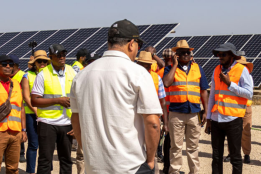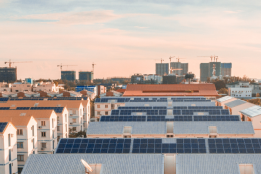Want to build a greener, cleaner, and more prosperous world for all? Look no further than your smartphone battery. Lithium ion batteries and other energy storage technologies—including molten salts, water pumps, air compression, and renewable hydrogen—could make all the difference in getting our economies on a more sustainable pathway.
Let’s back up a bit. Amid falling clean technology costs and increasingly favorable regulatory conditions, more communities are powered by renewable energy than ever before. Wind turbines and solar panels are respectively 40% and 80% cheaper than in 2009, and renewable energy accounts for a record 26% of global electricity generation.
Progress is being made, but barriers to a climate-smarter future persist. In particular, renewables such as wind or solar power are prone to intermittency, providing electricity only when the wind is blowing or the sun is shining. In order to generate round-the-clock clean power and narrow the global energy access gap, many countries, especially emerging economies, need an efficient, reliable, scaled, and affordable means of integrating energy into the electrical grid.
That’s why energy storage technologies are so important. They are among the most promising tools we have to expand integration of renewables more effectively, and with the speed and scale that the climate crisis demands. Many of these are mobile, rapidly deployable solutions in a world racing to address energy challenges brought on by harsh temperatures, operational and maintenance deficiencies, insufficient storage durations, and remote access.
With a total output of 11 gigawatt-hours (GWh), today’s market for stationary batteries is still in its infancy, especially when compared to the more mature electric vehicle (EV) battery industry. But batteries are far from the only storage technologies available.
There is a wide range of exciting ventures that could hold the key to unlocking fully renewable electricity grids. For example, flywheels store energy by spinning a rotor at exceptionally high speeds. Pumped hydropower storage is a gravity-based technology that releases stored energy by sending water down a natural incline. Molten salts use stored heat to drive an electricity-generating turbine. Hydrogen stores energy by harnessing one of the most abundant elements on the planet, supplying power stations, industry, and vehicles.
Greater investment is needed to mitigate risk and achieve economies of scale to expand critically important storage technologies. Enter CIF’s $250 million Global Energy Storage Program (GESP), which is helping drive over $1 billion of energy storage investments in developing countries. The program makes CIF the world’s largest multilateral fund supporting energy storage, building on over $400 million in existing storage support. Every dollar invested through GESP is expected to generate up to $8 in partner financing.
With the capital envisaged, this first-of-its-kind investment program aims to help develop approximately 17.5 GWh of new storage capacity in developing countries by 2025, support integration of at least an additional 16 gigawatts (GW) of wind and solar into grids, and expand energy access for 6.5 million people.
In particular, the concessional finance channeled through GESP will support initiatives including solar, wind, and hybrid power projects with storage components, policy and regulatory reforms, and enhance international cooperation around storage research, development and knowledge. Representatives from the private and public sectors are encouraged to apply and propose projects.
Never before has humanity faced a crisis like climate change. But at the same time, never before have we held so many resources to address it. Energy storage technologies supercharge progress toward a better climate future.




